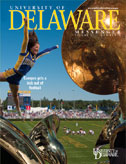Dye analysis gets to the point of artwork

RESEARCH | Even before they began working with decorative glass beads, early Native Americans used the dyed quills of porcupines to create intricate, colorful designs for stoles, bags, cradleboards, moccasins, wall hangings and other objects. And yet, the dyes used in such quillwork have never been scientifically studied.
When Christina Cole, a doctoral student in preservation studies, learned about that lack of analysis, a research project was launched.
“It was a case of a chemist looking for a project and a project looking for a chemist,” she says.
Cole recalls when she first became aware of quillwork while working at the Freer/Sackler Galleries and analyzing pigments and dyes in Chinese art. She met a Lakota traditional arts instructor through the National Museum of the American Indian, who commented that no one had analyzed the quill dyes that Native Americans used.
Unfamiliar with the subject, Cole visited the McCord Museum in Montreal for her first look at quillwork. Her reaction? “Wow!” she says.
“I was surprised, enchanted and astonished, and it took me a while to start examining quillwork from a clinical point of view.”
Cole, who is an analytical chemist and conservation scientist, was recently awarded a dissertation fellowship for her work by the American Association of University Women’s (AAUW) Educational Foundation. Fellows are “exceptional women whose work promises to enhance such diverse disciplines as biology, philosophy and anthropology,” according to AAUW. Cole also is a Coremans Endowment fellow, which funds doctoral students in art preservation.
Although she is studying quillwork predating the 1850s, the art continues today. One source of quills unfortunately is road kill, Cole says, with the porcupines dying from salt on the roads, “or you can throw a blanket over a porcupine and then remove the quills from the blanket.” Porcupines do not throw quills but they are easily detached, and the animals grow new ones.
The quills are sorted by size and then dyed and folded to make quillwork.
There have been studies of what dyes may have been used but none that completely eliminated uncertainty by examining the quillwork itself, Cole says. Thanks to modern technology and her research, many of the dyes now can be accurately pinpointed. Most of her work is carried out at the National Gallery of Art, where she uses a liquid chromatography-mass spectrometry instrument to analyze the dyes of quillwork from several collections.
“My goal is to be as non-invasive as possible, using swabs, for instance, to gather the material and to develop non-destructive methods of analysis,” Cole says.
She will be able to confirm that some black dyes are from walnut trees or from tannin, some blues from indigo or wild grapes, some yellows from goldenrod, and red-orange dyes from bloodroots. Even poison ivy may have been used as a dye.
By identifying the dyes, researchers can make better-informed decisions about how to preserve and interpret quillwork, as well as giving information on the materials to Native American communities, Cole says.
Article by Sue Moncure





